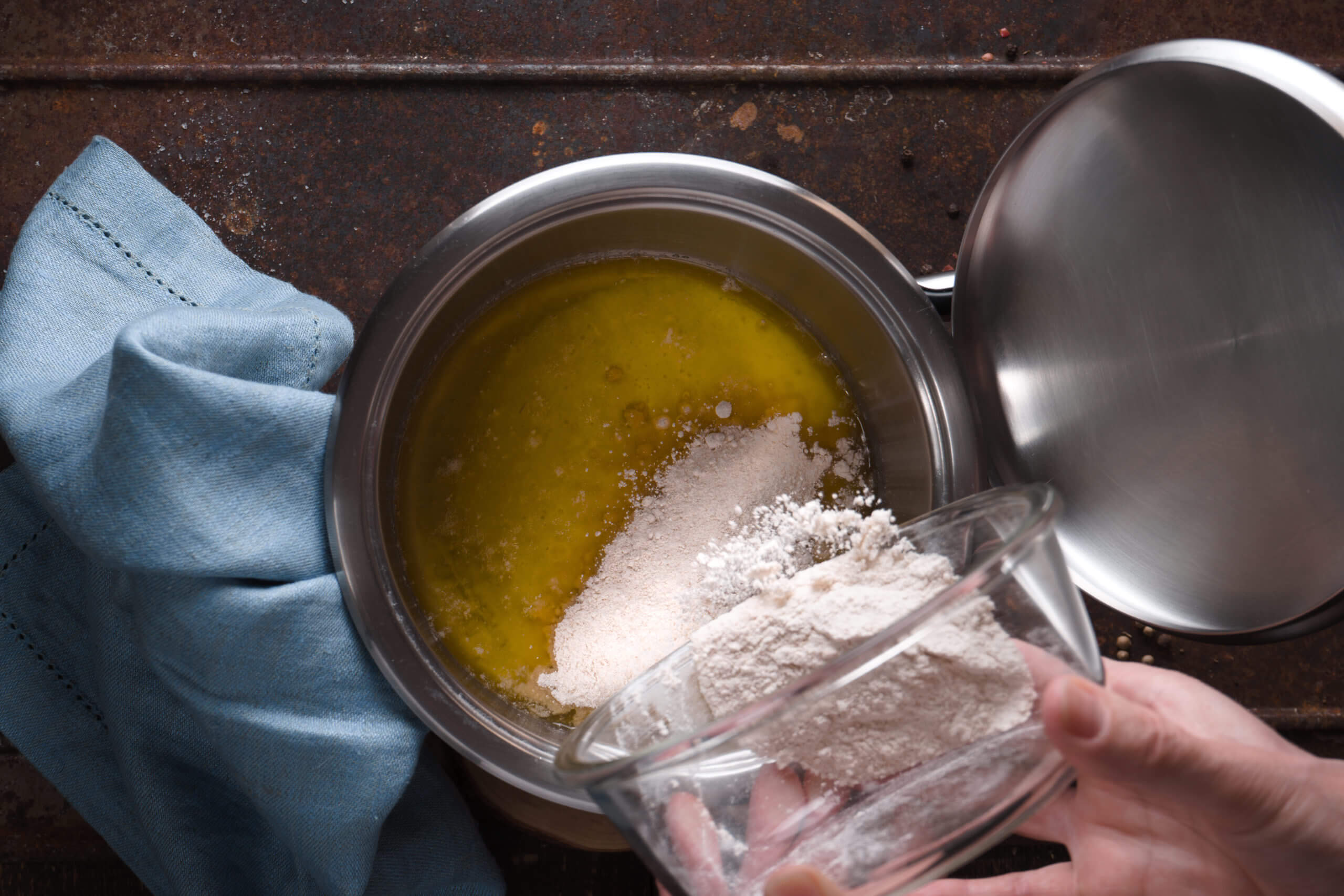How To Make Velouté
If you’re studying the culinary arts, you’ll learn how to make Velouté sauce. It’s one of Auguste Escoffier’s five French ‘mother sauces’.
It’s called a ‘mother sauce’ because it – along with Sauce Tomat, Béchamel, Hollandaise, and Espagnole – forms the foundation for hundreds of great sauces in French cuisine.
You’ll find the original recipe for Velouté in Chef Marie Antonin Carême’s famous 19th-century cookbook, The Art of French Cooking. Chef Escoffier, a contemporary of Carême’s, expanded on the original recipes, adding Hollandaise to the four Carême had created.
Knowing how to make Velouté – or any of the mother sauces – will elevate your culinary skills. It will provide you with a base for experimenting and creating your own unique sauces.
We’ll describe the method for making a Velouté sauce, and also share some of the ‘daughter sauces’ you can create once you have your base.
How to make Velouté sauce.
Like Béchamel, Velouté starts with a roux – equal parts fat and flour. The difference between the two sauces is that Velouté requires a clear or white stock – hence the ‘blonde’ color – whereas Béchamel uses milk.
The white stock is traditionally veal, but some recipes or dietary restrictions might require the use of chicken, fish or vegetable stock. While butter and wheat flour are also common ingredients, substitutions that accommodate special diets or allergies can be used with success. Rice flour, for example, is an excellent substitute for wheat flour – since it’s made from glutinous rice, it behaves like wheat flour in most recipes.
In order to make Velouté sauce gather the following ingredients:
- 2 cups white stock
- 3 tablespoons butter
- 3 tablespoons flour
- Salt and pepper to taste
First, create the roux. In a small saucepan, melt the butter on medium heat until it is frothy. Add the flour and continue to stir with a wooden spoon or whisk until the roux turns a pale golden color.
Keep in mind that if you’re looking for a traditional blonde Velouté you shouldn’t overcook the roux. It will continue to darken and the flavor will change, as well.
Whisk in the stock in ½-cup increments until the mixture is smooth. Then, add the desired amount of salt and pepper. Bring the sauce to a boil, reduce the heat and let it simmer for 20 minutes.
Culinary & Pastry Career Survey
Culinary & Pastry Career Survey
What's your ideal culinary career? Answer 20 simple questions and see if your dream career gets revealed to you.

We’ve compiled of all of the essential questions into one handy guide: Career options, description of skill requirements, and more!


Daughter sauces.
Once you have the base, there are no limits to the sauces you can create for your dish. Below are some of the more common daughter sauces derived from Velouté. Follow the directions from your specific recipe for measurements – this simply gives you a guide for the kinds of variations you can explore and the ingredients you’ll need on hand.
White wine sauce
Begin with a fish Velouté, add white wine, heavy cream, and lemon juice.
Sauce Allemande
This sauce is based on a veal stock Velouté with the addition of a few drops of lemon juice, cream, and egg yolks.
Sauce Normandy
After cooking a fish stock Velouté, add mushroom and oyster liquids along with cream and egg yolks.
Sauce Ravigote
Lemon juice and white wine vinegar lend acidity to this Velouté, which can be served warm or cold. Onions, shallots or mustard are traditionally added.
Sauce Poulette
Start with any variation of Velouté, add mushrooms, parsley, and lemon juice.
Supreme Sauce
This daughter sauce uses a chicken stock Velouté with the addition of mushroom liquor and cream.
Sauce Bercy
With a fish Velouté base, add white wine, shallots, lemon juice, and parsley.
Whether you’re a chef-in-training or studying the culinary arts for pleasure, mastering the five mother sauces is important. Even the humble macaroni and cheese dish begins with a mother sauce.
Learning how to make Velouté, the first of the mother sauces, will open up the possibilities for exploring cuisine.
Enjoyed this article? Here are 3 more you might enjoy:
- An Introduction To The 5 French Mother Sauces
- Top Apps For Finding Recipes For Ingredients You Already Have
- Auguste Escoffier School of Culinary Arts and America’s Test Kitchen Bring Best in Class to Today’s Home Cooks
This article was originally published on July 31, 2014, and has since been updated.


